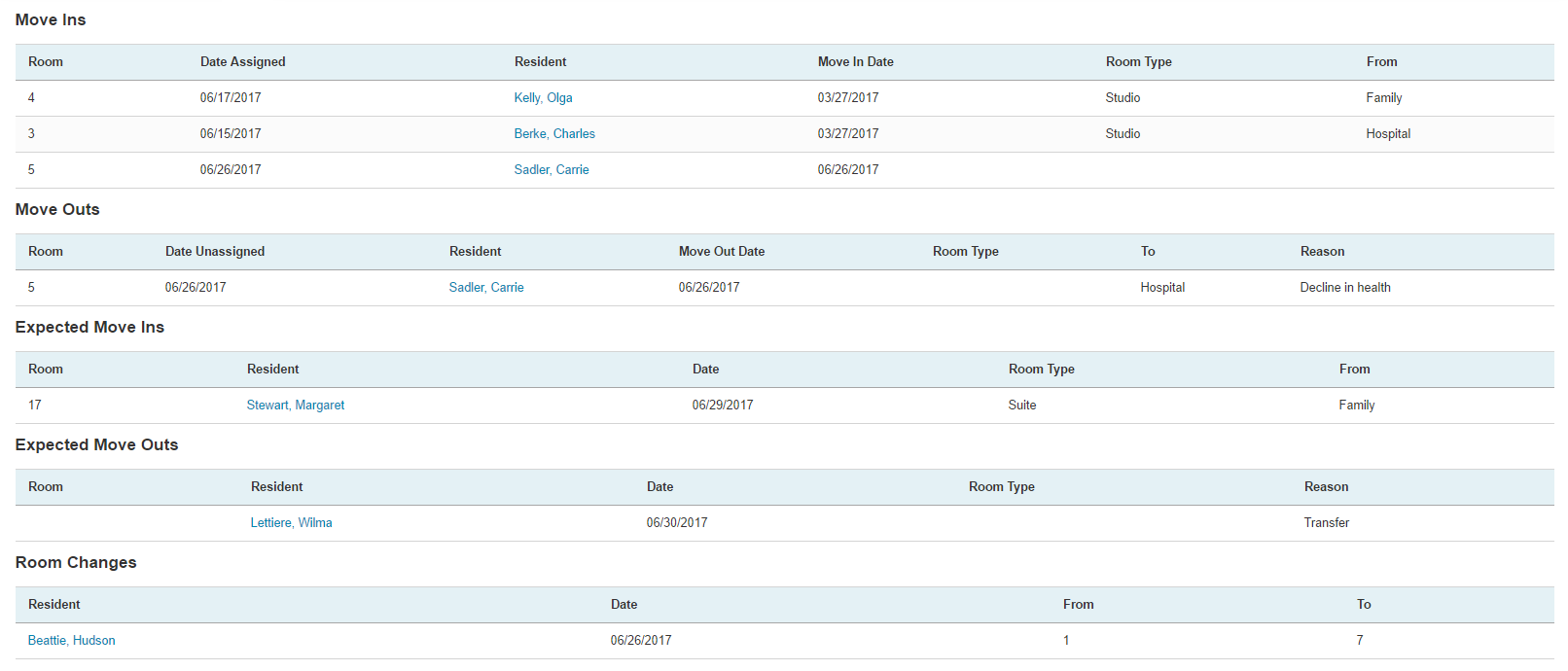Understanding the Occupancy Report
What is the Occupancy Report?
The updated Occupancy report, in the Resident Reports section of ALIS Reports, provides a quick overview of community activity and occupancy rates for a given date range in a single community. This report is useful for Community and Company operators who need to understand and report trends in total rent revenue in their facilities. Different from the Historical Census report, which shows the number of a days a resident has been on premise in a community, the Occupancy report shows the number of beds filled with residents in a month. Users can also see a detailed snapshot of just how full their community is, including actual and expected move ins, outs, and room changes.
Components of the Report:

- Room Category: Room Categories allow users to group Room Types together for more easily digestible data. Room Categories can be configured in Community Settings. Information about specific Room Type occupancy can be seen by exporting this report to Excel.
- Capacity: The Capacity shows the total number of units in your community that can be filled. This is not the actual number of filled beds in the community, but the maximum potential number that can be filled.
- Units (Capacity): unit capacity at the top will show you how many beds per Room Category there are in a community. Units will be explained in greater detail below.
- Unit Days: Unit Days Capacity displays the total number of days in the period, multiplied by the Unit Capacity. For example, if there are 10 units in a Room Category, and 12 days in a period, there will be 120 Unit Days. When viewing the report, the period will be the date range you select. This will default to display the current month.
- Summary: The Summary displays how many units have actually been filled in a community for a given period. The Res Days, or Resident Days, are the sum of all the financially occupied beds each day through the period. When a bed is assigned to a Resident, it will count in Resident Days whether they are On Premise or On Leave. The Unit Days Summary shows the number of days in the period, multiplied by the number of occupied units. Percentage: The percentage is calculated by dividing the Unit Days Summary by the Unit Days Capacity. If all units have been filled for the duration of the period, then this percentage will be 100%.
- Date: This column in the table will list, in date order, all days in your selected Date Range. This will default to display the current month, up to the day you are viewing the report.
- +/-: The plus and minus columns will display how many units have been assigned or unassigned to residents, respectively. In the Excel report, these columns are merged to show a total for the day. For example, if there are 3 residents assigned and 4 residents unassigned, the number in the Excel report will be -1.
- Units: How does ALIS count units based on the floor plan and room assignments? A unit is a bed, in brief. If a room has 4 beds, it has 4 units. The units displayed for each day show how many units have been assigned to residents for that day.
- 2nd Occ: If a bed has more than one occupant, the second occupant will be indicated in this column column. Users might find this scenario when there are married couples sharing a bed in their community This does not change the number of units, but allows users to easily keep track of how many beds have multiple residents assigned.
- The Percentage column in the Days section will show the occupancy percentage for each day.
Move Ins, Move Outs, and Room Changes in your community

Move Ins: When a resident is assigned a room for the first time in ALIS, they will appear in the Move Ins section. Users will be able to see to which room they were assigned, when they are assigned a room in ALIS, when they are expected to move in, the Room Type of their assigned room, and where they are moving in from (if listed).
Move Outs: Once a resident has been moved out, or is unassigned from their room without being assigned to a new room, they will appear in the Move Outs section. If they are moved out of the community, their destination and move out reason will display.
Expected Move Ins: Any Applicant or Resident in ALIS who has an expected Move In date recorded will appear in this section. Once they have been moved in, they will not appear here. This section displays all scheduled move ins, and not only move ins for the month.
Expected Move Outs: Any Resident with an Expected Move Out date recorded will appear in this section. Here, users will be able to see which room they are moving out of (and its Room Type), the expected date of their move, and the reason for their move.
Room Changes: When a Resident is assigned to a new room, they will appear in the Room Changes section. Here, users can see which room they left, and to which room they are moving.
Things to keep in mind:
If there are more than two people sharing a bed, the report will only count this multiple occupancy once in the 2nd Occ column. This column is counting the number of units that have multiple occupants assigned, not counting how many residents have been assigned.
If a resident is assigned and unassigned multiple rooms in a day, the Room Changes column will track each of these changes. Thus, a resident’s name will appear multiple times in Room Changes if they were moved to three different rooms in ALIS.
![]()
When you are working with the Occupancy report in ALIS, you can always click this “Need Help?” text, and be directed to this guide!
